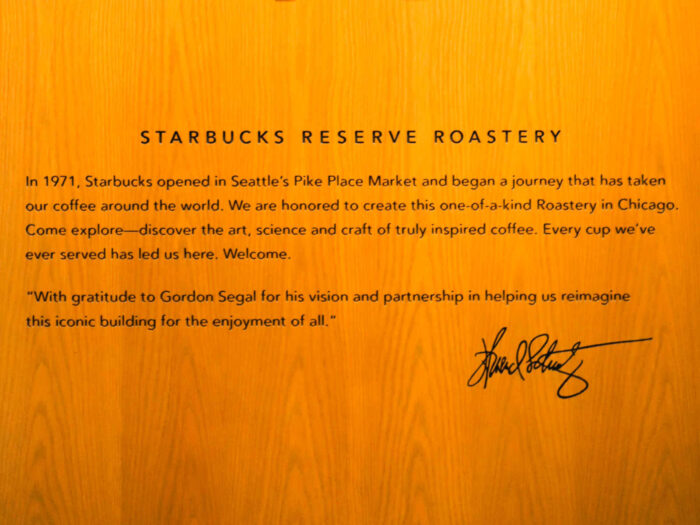
Starbucks’ mission statement and vision statement direct business operations toward leadership in the coffee market and the coffeehouse industry. The company’s mission and vision emphasize product quality and the social aspect of the coffeehouse chain.
This mission statement indicates what the business does for its target customers. In this business analysis case, the mission includes Starbucks’ philosophical purpose. In contrast, the vision statement reflects the strategic direction toward what the business wants to achieve. Starbucks’ vision focuses on industry leadership.
Success and competitiveness depend on implementing these corporate statements, which influence Starbucks’ generic competitive strategy and intensive growth strategies. Strategic goals enable the coffeehouse business to follow and satisfy its mission statement and vision statement.
Starbucks grows to satisfy its mission, vision, and purpose while competing with Tim Hortons and other coffeehouse chains, as well as foodservice businesses that offer coffee and other beverages, such as Dunkin’, McDonald’s, Burger King, Subway, and Wendy’s.
The Five Forces analysis of Starbucks shows that these competitors create tough rivalry in the coffeehouse industry. Starbucks’ competitive advantages advance the goals of its mission statement and vision statement despite competition.
Starbucks’ Mission Statement
Starbucks’ mission statement is “With every cup, with every conversation, with every community – we nurture the limitless possibilities of human connection.” Starbucks’ mission statement has the following components:
- Every cup, every conversation, every community
- Nurture limitless possibilities of human connection
Starbucks’ mission statement indicates a comprehensive and gradual approach. The “every cup, every conversation, every community” component shows that the coffeehouse business ensures meaningful impact on every employee and customer.
In parallel, this part of the corporate mission statement means that Starbucks’ business purpose and goals involve continually and gradually growing the multinational business, one place or community at a time.
Starbucks aims to “nurture limitless possibilities of human connection,” starting with its employees. To address this component of its mission statement, the coffeehouse company maintains a small-company culture, where rapport and warmth are important.
This social environment relates to Starbucks’ organizational culture (company culture), which promotes openness and meaningful interactions. Also, to support the mission’s social goal, the interior design of the company’s coffeehouses emphasizes warmth and coziness.
The same social component of the company’s mission statement extends the small-company culture to customers at the cafés to facilitate positive customer experience. For example, for a personal approach, employees’ and customers’ first names are used at Starbucks coffeehouses.
These approaches nurture meaningful and warm relations among baristas and consumers to satisfy the human-connection goals and business requirements based on Starbucks’ mission statement.

Starbucks’ Vision Statement
Starbucks’ vision is “to establish Starbucks as the premier purveyor of the finest coffee in the world while maintaining our uncompromising principles while we grow.” Starbucks’ vision statement has the following components:
- Premier purveyor status
- Finest coffee in the world
- Uncompromising principles
- Growth
The goal of being the premier purveyor means that Starbucks Corporation aims to achieve leadership in providing its products, especially coffee of the best quality. The company achieves this premier-status objective of its vision statement by continuing its multinational expansion as one of the largest coffee and coffeehouse companies in the world.
However, it is not yet clear if Starbucks effectively addresses the “finest coffee in the world” component of its corporate vision. The company competes with many coffeehouses, including local ones, in terms of coffee quality.
Nonetheless, the “uncompromising principles” component of Starbucks’ vision statement is addressed in the coffeehouse chain’s operations. The company maintains these principles, such as ethical business conduct and a warm culture, as established during Howard Schultz’s leadership.
Also, the “growth” component and goal of Starbucks’ vision statement is satisfied through the continuing global expansion of the coffeehouse chain business alongside new store locations and new product development.
The business competitive advantages, core competencies, and capabilities discussed in the SWOT analysis of Starbucks enable this business growth to satisfy the long-term goals of the company’s vision statement.
An Assessment of Starbucks’ Mission and Vision
Starbucks’ mission statement is sufficiently abstract to make it applicable to future business scenarios. However, this corporate mission does not satisfy many of the conventional characteristics of ideal mission statements. For example, Starbucks’ mission statement does not inform about target customers, types of products, and target markets.
While the coffee company presents a facet of its business philosophy and business purpose, the resulting mission statement needs improvement to satisfy ideal conventions. It is recommended that Starbucks add more information into its mission statement to provide a more holistic representation of the business, its operations, goals, objectives, and targets.
Starbucks’ vision statement is concise, clear, and inspiring, especially in terms of achieving and maintaining the premier status in the coffeehouse and coffee industry. This focus on leadership is a motivator that challenges management and employees, including baristas.
Moreover, the corporate vision is stable in terms of applicability to future business scenarios at Starbucks Corporation. The “premier purveyor” component is applicable in the long term, as the business continues to build its coffee products, foodservice, and merchandise operations.
However, Starbucks does not include new business operations and products in its vision statement. For example, tea, other caffeinated drinks, pastry, and merchandise (consumer goods) are now part of the product mix, as outlined in Starbucks’ marketing mix or 4Ps. These products can be included in the company’s vision statement.
An applicable recommendation to improve Starbucks’ vision statement is to add these pieces of information regarding the product mix. This modification can make the vision statement more accurate in representing current business operations extending beyond coffee.
References
- About Starbucks Coffee Company.
- Aljebrini, A., Dogruyol, K., & Ahmaro, I. Y. (2025). How strategic planning enhances ESG: Evidence from mission statements. Sustainability, 17(2), 595.
- Jaworski, B., & Cheung, V. (2023). Getting Started on the Journey: Mission, Vision, and Purpose. In Creating the Organization of the Future (pp. 55-64). Emerald Publishing Limited.
- Starbucks Coffee Company Culture.
- Starbucks Corporation Form 10-K.
- Zhang, B., & Ip, W. S. C. (2025). Starbucks’ critical success factors based on customer perception. Highlights in Business, Economics and Management, 49, 104-119.